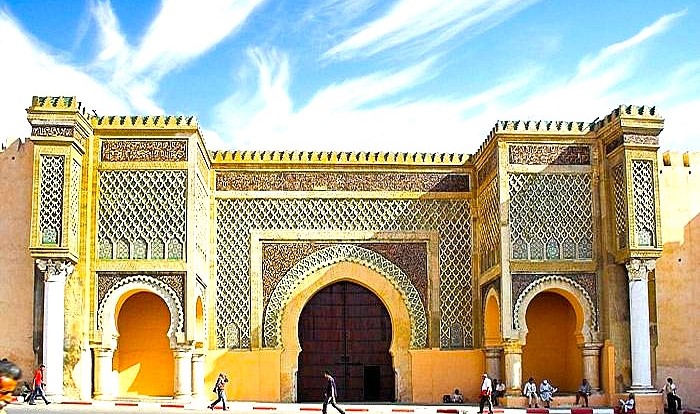Historic Monuments of Meknes: Explore Morocco’s Imperial Heritage
Meknes, often called the “Versailles of Morocco,” is a city where historic monuments tell the story of imperial ambition, architectural grandeur, and Moroccan artistry. Founded in the 11th century but transformed into an imperial capital by Sultan Moulay Ismail in the 17th century, Meknes stands as a testament to the power and vision of Morocco’s dynasties.
Visitors to Meknes will immediately notice the city’s massive ramparts, ornate gates, and sprawling palaces, all of which reflect the sultan’s desire to rival European capitals. Sites such as the Bab Mansour gate, the Heri es-Souani granaries, and the Dar Jamai Museum offer travelers a rich journey through Morocco’s imperial history.
Meknes is more than a collection of monuments. Its medina, gardens, and historic squares showcase living Moroccan culture, where artisans, markets, and local traditions continue to thrive alongside centuries-old architecture. For those exploring Morocco’s imperial cities, Meknes provides a unique glimpse into the opulence and strategic importance of Morocco’s historic capitals.
Sultan Moulay Ismail and the Rise of Meknes as an Imperial Capital
Meknes owes much of its imperial grandeur to Sultan Moulay Ismail, who ruled Morocco from 1672 to 1727. Known as one of the most powerful rulers in Moroccan history, he transformed Meknes into a symbol of authority and architectural ambition, rivaling European capitals in scale and splendor. For travelers exploring the historic monuments of Meknes, understanding Moulay Ismail’s influence is essential, as nearly every iconic site in the city stems from his reign.
Under Moulay Ismail, Meknes became a fortified city, featuring massive walls, imposing gates, and expansive palaces. The sultan’s vision was not only to protect his empire but also to demonstrate Morocco’s imperial power and artistic sophistication. The construction projects, which involved tens of thousands of laborers, included monumental gates like Bab Mansour, the royal stables, and vast granaries such as the Heri es-Souani.
Moulay Ismail’s Meknes was designed to impress foreign diplomats, house thousands of soldiers, and sustain a growing population with grand infrastructure. Today, the historic monuments of Meknes remain a testament to his ambition, blending military strategy, architectural elegance, and urban planning into a city that still captures the imagination of travelers.
For those exploring Morocco’s imperial cities, Meknes offers a unique opportunity to witness the vision of a ruler who sought to leave a lasting legacy through stone, tile, and monumental design.

Bab Mansour Gate: The Grand Entrance to an Imperial City
The Bab Mansour gate is the most iconic of Meknes’ historic monuments and a masterpiece of Moroccan architecture. Commissioned by Sultan Moulay Ismail and completed in the early 18th century, Bab Mansour was designed to impress both visitors and rivals, symbolizing the power and grandeur of the imperial city.
Constructed using white marble columns imported from the Roman ruins of Volubilis, the gate combines Islamic and Moroccan architectural elements, including intricate zellige tilework, carved inscriptions, and imposing archways. Its size and elegance make it not only a functional city gate but also a monumental statement of authority. Travelers exploring the historic monuments of Meknes will find that Bab Mansour serves as the perfect introduction to the city’s imperial character.
Adjacent to Bab Mansour is Place El Hedim, the city’s main square, where locals and tourists gather amidst the vibrant atmosphere of markets and street performers. This lively space contrasts beautifully with the solemn majesty of the gate, creating a dynamic experience that blends history and contemporary Moroccan culture.
For anyone visiting Morocco’s imperial cities, Bab Mansour remains a must-see landmark, exemplifying the fusion of military engineering, decorative artistry, and the ambitious vision of Sultan Moulay Ismail. Its enduring presence continues to captivate travelers and offers a tangible link to Meknes’ imperial past.

Heri es-Souani Granaries and the Royal Stables
Among Meknes’ most impressive historic monuments are the Heri es-Souani granaries and the Royal Stables, both commissioned by Sultan Moulay Ismail as part of his grand vision for the imperial city. These monumental constructions reflect the sultan’s ambition to combine functionality, security, and architectural mastery in service of his empire.
The Heri es-Souani granaries were designed to store large quantities of grain to sustain the city’s population and army, showcasing advanced engineering and logistical planning for the 17th century. Visitors can walk among the vaulted storage chambers, which are remarkable for their scale and craftsmanship, and imagine the bustling activity that once filled the corridors with grain and supplies.
Nearby, the Royal Stables housed up to 12,000 horses, reflecting the importance of cavalry in Sultan Moulay Ismail’s military campaigns. The stables feature arched galleries, intricate masonry, and practical design, blending utility with the aesthetic standards of the time. Both the granaries and stables are essential stops for anyone exploring the historic monuments of Meknes, as they highlight the city’s role as a military and administrative hub.
These sites also demonstrate Meknes’ urban planning sophistication, with careful consideration of logistics, defense, and royal prestige. Visitors following the trail of Morocco’s imperial cities will find that the Heri es-Souani granaries and Royal Stables provide a unique window into the daily life and strategic priorities of one of Morocco’s most powerful rulers.

Dar Jamai Museum and Meknes’ Cultural Legacy
Meknes is not only a city of monumental architecture but also a hub of Moroccan arts and culture, exemplified by the Dar Jamai Museum. Housed in a 19th-century palace, the museum preserves an impressive collection of traditional Moroccan arts, including ceramics, textiles, jewelry, and woodwork. For travelers exploring the historic monuments of Meknes, the museum provides a deeper understanding of the artistic traditions that flourished alongside the city’s imperial achievements.
The palace itself is a masterpiece, featuring ornate courtyards, intricate zellige mosaics, carved cedar ceilings, and tranquil gardens. These architectural elements reflect the fusion of Moroccan and Andalusian design, offering visitors a glimpse into the aesthetic tastes of the city’s elite. Walking through Dar Jamai allows travelers to experience both the visual beauty and historical significance of Meknes’ cultural heritage.
The museum also hosts exhibitions and cultural events that highlight the living traditions of Moroccan craftsmanship, connecting the past to contemporary artistic expressions. From handwoven carpets to delicate metalwork, each artifact tells a story of the city’s rich cultural fabric.
For visitors exploring Morocco’s imperial cities, Dar Jamai Museum complements the city’s monumental architecture by offering a more intimate, human-scale perspective on Meknes’ imperial past. It demonstrates that the city’s legacy is not only built from stone and mortar but also from the creativity and skill of generations of Moroccan artisans.
Discover The Historic Monuments of Meknes!
Let our travel experts at Holiday Morocco Tours craft your journey through the city’s living heritage. From guided tours of palaces and gates to immersive cultural experiences, we ensure your Moroccan adventure is authentic, memorable, and deeply connected to history.
Don’t just read about Meknes’s historic monuments, experience them firsthand!
Preservation and Living Heritage of Meknes
Meknes is a city where history is alive, and the preservation of its historic monuments is central to its identity. From the grandeur of Bab Mansour to the practical brilliance of the Heri es-Souani granaries, the city’s sites are carefully maintained to ensure that travelers can experience Morocco’s imperial legacy authentically.
UNESCO Recognition and Restoration Efforts
The medina of Meknes, along with its historic monuments, has been recognized as a UNESCO World Heritage Site, highlighting its architectural, historical, and cultural value. Restoration projects focus on key landmarks, including Bab Mansour, the Royal Stables, and the city walls, preserving both their structural integrity and decorative artistry. These initiatives ensure that Meknes’ historic monuments remain accessible and inspiring for future generations.
A Living Imperial City
Unlike cities where historic sites feel static, Meknes thrives as a living imperial city. Local artisans continue centuries-old trades in the medina, markets bustle with daily life, and cultural traditions are actively practiced. Visitors exploring the historic monuments of Meknes experience the city not as a museum but as a vibrant community where past and present coexist seamlessly.
Cultural Festivals and Traditions
Meknes celebrates its heritage through cultural events that bring the city’s historic spaces to life. From traditional music and storytelling in the medina to exhibitions of Moroccan crafts at sites like Dar Jamai Museum, the city demonstrates how living heritage can complement monumental history.
Safeguarding Heritage for the Future
Preserving Meknes’ historic monuments goes beyond restoring buildings. Initiatives include training local artisans, revitalizing neighborhoods, and promoting sustainable tourism. These efforts ensure that the city’s imperial legacy continues to inspire travelers while maintaining its authenticity and vitality.
For those exploring Morocco’s imperial cities, Meknes provides a unique perspective — a city where imperial ambition, cultural richness, and modern life intersect, offering a complete understanding of Morocco’s historic landscape.
Experience Meknes: Walk Through Morocco’s Imperial Heritage
Meknes, the “Versailles of Morocco,” invites travelers to explore historic monuments of Meknes that span centuries of imperial ambition, architectural mastery, and cultural richness. From the monumental Bab Mansour to the impressive Heri es-Souani granaries, the city’s landmarks reflect Sultan Moulay Ismail’s vision of a grand imperial capital.
Walking through the medina, visiting the Royal Stables, and exploring the Dar Jamai Museum offers travelers a complete immersion into Morocco’s imperial past, blending monumental architecture with vibrant cultural life. Every street, gate, and courtyard tells a story of ambition, artistry, and tradition, making Meknes a must-visit among Morocco’s imperial cities.
